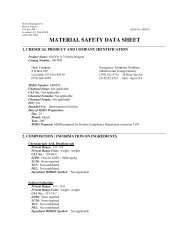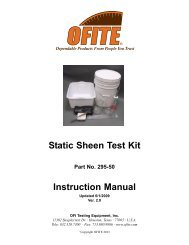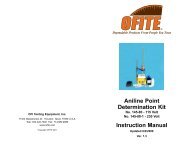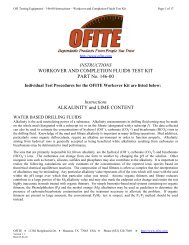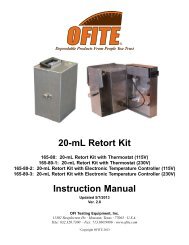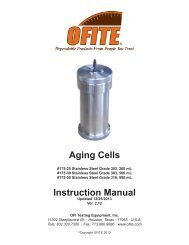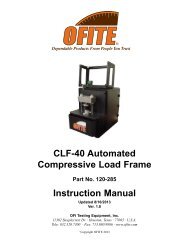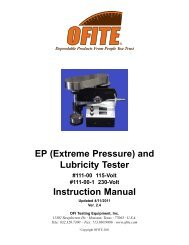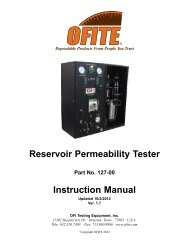Eriochrome Black T Indicator Powder - OFI Testing Equipment, Inc.
Eriochrome Black T Indicator Powder - OFI Testing Equipment, Inc.
Eriochrome Black T Indicator Powder - OFI Testing Equipment, Inc.
You also want an ePaper? Increase the reach of your titles
YUMPU automatically turns print PDFs into web optimized ePapers that Google loves.
<strong>Eriochrome</strong> <strong>Black</strong> T <strong>Indicator</strong> <strong>Powder</strong><br />
Safety Data Sheet<br />
Revision date: 03/07/2013<br />
SECTION 1: IDENTIFICATION OF THE SUBSTANCE/MIXTURE AND OF THE COMPANY<br />
Product Identifier<br />
Product name: <strong>Eriochrome</strong> <strong>Black</strong> T <strong>Indicator</strong> <strong>Powder</strong><br />
CAS No.: 1787-61-7<br />
Product code: 205-28<br />
Intended Use Of The Product<br />
Use of the substance/preparation: Laboratory Reagent<br />
Name, Address, And Telephone Of The Responsible Party<br />
<strong>OFI</strong> <strong>Testing</strong> <strong>Equipment</strong>, <strong>Inc</strong>.<br />
11302 Steeplecrest Dr.<br />
Houston, TX 77065 USA<br />
+1-832-320-7300<br />
http://www.ofite.com/<br />
Emergency Telephone Number<br />
Emergency number : INFOTRAC USA and Canada: 1-800-535-5053 / INFOTRAC Outside USA and Canada: 1-352-323-3500<br />
SECTION 2: HAZARDS IDENTIFICATION<br />
Classification Of The Substance Or Mixture<br />
Classification (GHS-US)<br />
Comb. Dust<br />
STOT SE 3 H335<br />
Label Elements<br />
GHS-US labeling<br />
Hazard pictograms (GHS-US) :<br />
GHS07<br />
Signal word (GHS-US) : Warning<br />
Hazard statements (GHS-US) : H232 - May form combustible dust concentrations in air<br />
H335 - May cause respiratory irritation (through inhalation)<br />
Precautionary statements<br />
(GHS-US)<br />
: P261 - Avoid breathing dust.<br />
P271 - Use only outdoors or in a well-ventilated area<br />
P304+P340 - IF INHALED: Remove person to fresh air and keep comfortable for breathing<br />
P312 - Call a POISON CENTER or doctor if you feel unwell<br />
P403+P233 - Store in a well-ventilated place. Keep container tightly closed<br />
P405 - Store locked up<br />
P501 - Dispose of contents/container in accordance with all local, regional, national, provincial,<br />
territorial and international regulations.<br />
02/04/2013 EN (English US) 1/8
<strong>Eriochrome</strong> <strong>Black</strong> T <strong>Indicator</strong> <strong>Powder</strong><br />
Safety Data Sheet<br />
according to Federal Register / Vol. 77, No. 58 / Monday, March 26, 2012 / Rules and Regulations<br />
Other Hazards<br />
Other hazards not contributing to the classification:<br />
Hazardous to the aquatic environment – Acute Hazard Category 1.<br />
H400 - Very toxic to aquatic life.<br />
Unknown acute toxicity (GHS US) Not available<br />
SECTION 3: COMPOSITION/INFORMATION ON INGREDIENTS<br />
Substances<br />
Name Product identifier % (w/w) Classification (GHS-US)<br />
1-Naphthalenesulfonic acid, 3-hydroxy-4-[(1-hydroxy-2-<br />
naphthalenyl)azo]-7-nitro-, monosodium salt<br />
(CAS No.) 1787-61-7 100 Comb. Dust<br />
STOT SE 3 (inhalation), H335<br />
Full text of H-phrases: see section 16<br />
SECTION 4: FIRST AID MEASURES<br />
Description Of First Aid Measures<br />
General: Never give anything by mouth to an unconscious person. If you feel unwell, seek medical advice (show the label where<br />
possible).<br />
Inhalation: When symptoms occur: go into open air and ventilate suspected area. Call a POISON CENTER/doctor/physician if you feel<br />
unwell.<br />
Skin Contact: Gently wash with plenty of soap and water.<br />
Eye Contact: Rinse cautiously with water for several minutes. Remove contact lenses, if present and easy to do. Continue rinsing.<br />
Obtain medical attention if pain, blinking or redness persist.<br />
Ingestion: Ingestion is not an anticipated route of exposure. If accidental ingestion occurs, flush mouth out with water and get<br />
medical attention.<br />
Most Important Symptoms And Effects Both Acute and Delayed<br />
General: Irritation of respiratory tract.<br />
Inhalation: May cause respiratory irritation.<br />
Skin Contact: Prolonged contact with large amounts of dust may cause mechanical irritation.<br />
Eye Contact: Direct contact with dust may cause mechanical irritation.<br />
Ingestion: If a large quantity has been ingested: abdominal pain.<br />
Chronic symptoms: Not available<br />
Indication Of Any Immediate Medical Attention And Special Treatment Needed<br />
If you feel unwell, seek medical advice (show the label where possible).<br />
SECTION 5: FIREFIGHTING MEASURES<br />
Extinguishing Media<br />
Suitable extinguishing media: Use extinguishing media appropriate for surrounding fire.<br />
Unsuitable extinguishing media: Do not use a heavy water stream.<br />
Special Hazards Arising From The Substance Or Mixture<br />
Fire hazard: None known. Refer to section 9 for flammability properties.<br />
Explosion hazard: Dust clouds can be explosive.<br />
Reactivity: None.<br />
Advice For Firefighters<br />
Precautionary measures fire: Not available<br />
02/04/2013 EN (English US) 2/8
<strong>Eriochrome</strong> <strong>Black</strong> T <strong>Indicator</strong> <strong>Powder</strong><br />
Safety Data Sheet<br />
according to Federal Register / Vol. 77, No. 58 / Monday, March 26, 2012 / Rules and Regulations<br />
Firefighting instructions: Use water spray or fog for cooling exposed containers. Exercise caution when fighting any chemical fire.<br />
Do not allow run-off from fire fighting to enter drains or water courses.<br />
Protection during firefighting: Do not enter fire area without proper protective equipment, including respiratory protection.<br />
Hazardous Combustion Products: Carbon oxides (CO 2 , CO), nitrogen oxides (NO, NO 2 ) and some metallic oxides.<br />
SECTION 6: ACCIDENTAL RELEASE MEASURES<br />
Personal Precautions, Protective <strong>Equipment</strong> And Emergency Procedures<br />
General measures: Do not allow product to spread into the environment.<br />
For Non-Emergency Personnel<br />
Protective equipment: Use appropriate personal protection equipment (PPE).<br />
Emergency procedures: Evacuate unnecessary personnel.<br />
For Emergency Personnel<br />
Protective equipment: Equip cleanup crew with proper protection.<br />
Emergency procedures: Ventilate area.<br />
Environmental Precautions<br />
Prevent entry to sewers and public waters. Avoid release to the environment.<br />
Methods And Material For Containment And Cleaning Up<br />
For containment: Ventilate area. Contain and collect as any solid.<br />
Methods for cleaning up: Collect absorbed material and place into a sealed, labelled container for proper disposal. Avoid<br />
generation of dust during clean-up of spills.<br />
Reference To Other Sections<br />
See Heading 8, Exposure controls and personal protection.<br />
SECTION 7: HANDLING AND STORAGE<br />
Precautions For Safe Handling<br />
Hygiene measures: Handle in accordance with good industrial hygiene and safety procedures. Wash hands and other exposed<br />
areas with mild soap and water before eating, drinking, or smoking and again when leaving work. Avoid breathing dust, mist or<br />
spray.<br />
Conditions For Safe Storage, <strong>Inc</strong>luding Any <strong>Inc</strong>ompatibilities<br />
Storage conditions: Keep container tightly closed,Keep only in the original container in a cool, well ventilated place away from:<br />
sparks, heat, open flame and other sources of ignition.<br />
Specific End Use(s) Laboratory Reagent<br />
SECTION 8: EXPOSURE CONTROLS/PERSONAL PROTECTION<br />
Control Parameters<br />
No Occupational Exposure Limits have been established for the product.<br />
Exposure Controls<br />
Appropriate engineering controls: Ensure all national/local regulations are observed. Ensure adequate ventilation, especially in<br />
confined areas.Take precautionary measures against static discharges.<br />
Personal protective equipment: Avoid all unnecessary exposure. Dust formation: dust mask. Gloves. Eye protection.<br />
Hand protection: Wear protective gloves.<br />
Eye protection: In laboratory, medical or industrial settings, or operations in which airborne particulates will be generated, safety<br />
glasses with side shields are recommended.<br />
02/04/2013 EN (English US) 3/8
<strong>Eriochrome</strong> <strong>Black</strong> T <strong>Indicator</strong> <strong>Powder</strong><br />
Safety Data Sheet<br />
according to Federal Register / Vol. 77, No. 58 / Monday, March 26, 2012 / Rules and Regulations<br />
Respiratory protection: Where exposure through inhalation may occur from use, respiratory protection equipment is<br />
recommended.<br />
Environmental exposure controls: Avoid release to the environment.<br />
Other information: When using, do not eat, drink or smoke.<br />
SECTION 9:<br />
PHYSICAL AND CHEMICAL PROPERTIES<br />
Information On Basic Physical And Chemical Properties<br />
Physical state : Solid<br />
Appearance : Dark red powder<br />
Odor : Not available<br />
Odor threshold : Not available<br />
pH : Not available<br />
Relative evaporation rate (butyl acetate=1) : Not available<br />
Melting point : > 300 °C (>572°F)<br />
Freezing point : Not available<br />
Boiling point : Not available<br />
Flash point : Not available<br />
Auto-ignition temperature : 220 °C (428°F)<br />
Decomposition Temperature : Not available<br />
Flammability (solid, gas) : Not available<br />
Lower flammable limit : Not available<br />
Upper flammable limit : Not available<br />
Vapor pressure : Not available<br />
Relative vapor density at 20 °C : Not available<br />
Relative density : Not available<br />
Specific gravity density : Not available<br />
Solubility : Soluble in water: 2.93 g/l (at 20°C)<br />
Log Pow : Not available<br />
Log Kow : Not available<br />
Viscosity, kinematic : Not available<br />
Viscosity, dynamic : Not available<br />
Explosion data - sensitivity to mechanical impact : Not available<br />
Explosion data - sensitivity to static discharge : Not available<br />
SECTION 10: STABILITY AND REACTIVITY<br />
Reactivity None.<br />
Chemical Stability<br />
Possibility Of Hazardous Reactions<br />
Conditions To Avoid<br />
<strong>Inc</strong>ompatible Materials<br />
Hazardous Decomposition Products<br />
Stable at standard temperature and pressure.<br />
Hazardous polymerization will not occur.<br />
Avoid creating or spreading dust.<br />
Strong acids. Strong bases.<br />
Carbon oxides (CO 2 , CO), nitrogen oxides (NO, NO 2 ) and some metallic oxides.<br />
SECTION 11: TOXICOLOGICAL INFORMATION<br />
Information On Toxicological Effects - Product<br />
Acute toxicity<br />
: Not classified<br />
LD50 and LC50 Data<br />
1-Naphthalenesulfonic acid, 3-hydroxy-4-[(1-hydroxy-2-naphthalenyl)azo]-7-nitro-, monosodium salt (1787-61-7)<br />
LD50 oral rat<br />
17590 mg/kg<br />
02/04/2013 EN (English US) 4/8
<strong>Eriochrome</strong> <strong>Black</strong> T <strong>Indicator</strong> <strong>Powder</strong><br />
Safety Data Sheet<br />
according to Federal Register / Vol. 77, No. 58 / Monday, March 26, 2012 / Rules and Regulations<br />
LD50 dermal rabbit<br />
> 3000 mg/kg<br />
LC50 inhalation rat (mg/l) > 2 mg/l (Exposure time: 4 h)<br />
ATE (oral)<br />
17590 mg/kg<br />
Skin corrosion/irritation: Not classified<br />
Serious eye damage/irritation: Not classified<br />
Respiratory or skin sensitization: Not classified<br />
Germ cell mutagenicity: Not classified<br />
Teratogenicity: Not available<br />
Carcinogenicity: Not classified<br />
Specific target organ toxicity (repeated exposure): Not classified<br />
Reproductive toxicity: Not classified<br />
Specific target organ toxicity (single exposure): May cause respiratory irritation.<br />
Aspiration hazard: Not classified<br />
Symptoms/injuries after inhalation: May cause respiratory irritation.<br />
Symptoms/injuries after skin contact: Prolonged contact with large amounts of dust may cause mechanical irritation.<br />
Symptoms/injuries after eye contact: Prolonged contact with large amounts of dust may cause mechanical irritation.<br />
Symptoms/injuries after ingestion: If a large quantity has been ingested: abdominal pain.<br />
SECTION 12: ECOLOGICAL INFORMATION<br />
Toxicity<br />
Ecology - general: Very toxic to aquatic life.<br />
<strong>Eriochrome</strong> <strong>Black</strong> T <strong>Indicator</strong> <strong>Powder</strong> (1787-61-7)<br />
LC50 fish 1<br />
EC50 Daphnia 1<br />
LC50 fish 2<br />
ErC50 (algae)<br />
6 mg/l<br />
41.3 mg/l<br />
7.3 mg/l<br />
0.092 mg/l<br />
1-Naphthalenesulfonic acid, 3-hydroxy-4-[(1-hydroxy-2-naphthalenyl)azo]-7-nitro-, monosodium salt (1787-61-7)<br />
LC50 fish 1<br />
12.3 mg/l (Exposure time: 96 h - Species: Brachydanio rerio [static])<br />
EC50 Daphnia 1<br />
41.3 mg/l (Exposure time: 48 h - Species: Daphnia magna)<br />
EC50 other aquatic organisms 1<br />
0.094 mg/l (Exposure time: 72 h - Species: Desmodesmus subspicatus)<br />
LC50 fish 2<br />
7.3 mg/l (Exposure time: 96 h - Species: Oncorhynchus mykiss [static])<br />
NOEC (acute)<br />
< 12.3 mg/kg (Exposure time: 14 Days - Species: Eisenia foetida [soil dry<br />
weight])<br />
Persistence And Degradability<br />
<strong>Eriochrome</strong> <strong>Black</strong> T <strong>Indicator</strong> <strong>Powder</strong> (1787-61-7)<br />
Persistence and degradability<br />
Bioaccumulative Potential<br />
<strong>Eriochrome</strong> <strong>Black</strong> T <strong>Indicator</strong> <strong>Powder</strong> (1787-61-7)<br />
Bioaccumulative potential<br />
Mobility In Soil Not available<br />
Other Adverse Effects<br />
Other information: Avoid release to the environment.<br />
May cause long-term adverse effects in the environment.<br />
Not established.<br />
SECTION 13: DISPOSAL CONSIDERATIONS<br />
Waste disposal recommendations: Dispose of waste material in accordance with all local, regional, national, provincial, territorial<br />
and international regulations.<br />
02/04/2013 EN (English US) 5/8
<strong>Eriochrome</strong> <strong>Black</strong> T <strong>Indicator</strong> <strong>Powder</strong><br />
Safety Data Sheet<br />
according to Federal Register / Vol. 77, No. 58 / Monday, March 26, 2012 / Rules and Regulations<br />
Ecology - waste materials: Avoid release to the environment. This material is hazardous to the aquatic environment. Keep out of<br />
sewers and waterways.<br />
SECTION 14: TRANSPORT INFORMATION<br />
In accordance with ICAO/IATA/DOT/TDG<br />
UN Number<br />
UN-No.(DOT): 3077<br />
DOT NA no.: UN3077<br />
UN Proper Shipping Name<br />
DOT Proper Shipping Name : Environmentally hazardous substances, solid, n.o.s.<br />
Department of Transportation (DOT) Hazard : 9 - Class 9 - Miscellaneous hazardous material 49 CFR 173.140<br />
Classes<br />
Hazard labels (DOT) : 9 - Miscellaneous dangerous compounds<br />
DOT Symbols : G - Identifies PSN requiring a technical name<br />
Packing group (DOT) : III - Minor Danger<br />
DOT Special Provisions (49 CFR 172.102) : 8 - A hazardous substance that is not a hazardous waste may be shipped under<br />
the shipping description “Other regulated substances, liquid or solid, n.o.s.”, as<br />
appropriate. In addition, for solid materials, special provision B54 applies.<br />
146 - This description may be used for a material that poses a hazard to the<br />
environment but does not meet the definition for a hazardous waste or a<br />
hazardous substance, as defined in 171.8 of this subchapter, or any hazard class<br />
as defined in Part 173 of this subchapter, if it is designated as environmentally<br />
hazardous by the Competent Authority of the country of origin, transit or<br />
destination.<br />
335 - Mixtures of solids that are not subject to this subchapter and<br />
environmentally hazardous liquids or solids may be classified as<br />
“Environmentally hazardous substances, solid, n.o.s,” UN3077 and may be<br />
transported under this entry, provided there is no free liquid visible at the time<br />
the material is loaded or at the time the packaging or transport unit is closed.<br />
Each transport unit must be leak-proof when used as bulk packaging.<br />
B54 - Open-top, sift-proof rail cars are also authorized.<br />
IB8 - Authorized IBCs: Metal (11A, 11B, 11N, 21A, 21B, 21N, 31A, 31B and 31N);<br />
Rigid plastics (11H1, 11H2, 21H1, 21H2, 31H1 and 31H2); Composite (11HZ1,<br />
11HZ2, 21HZ1, 21HZ2, 31HZ1 and 31HZ2); Fiberboard (11G); Wooden (11C, 11D<br />
and 11F); Flexible (13H1, 13H2, 13H3, 13H4, 13H5, 13L1, 13L2, 13L3, 13L4,<br />
13M1 or 13M2).<br />
IP3 - Flexible IBCs must be sift-proof and water-resistant or must be fitted with<br />
a sift-proof and water-resistant liner.<br />
N20 - A 5M1 multi-wall paper bag is authorized if transported in a closed<br />
transport vehicle.<br />
T1 - 1.5 178.274(d)(2) Normal............. 178.275(d)(2)<br />
TP33 - The portable tank instruction assigned for this substance applies for<br />
granular and powdered solids and for solids which are filled and discharged at<br />
temperatures above their melting point which are cooled and transported as a<br />
solid mass. Solid substances transported or offered for transport above their<br />
melting point are authorized for transportation in portable tanks conforming to<br />
the provisions of portable tank instruction T4 for solid substances of packing<br />
group III or T7 for solid substances of packing group II, unless a tank with more<br />
02/04/2013 EN (English US) 6/8
<strong>Eriochrome</strong> <strong>Black</strong> T <strong>Indicator</strong> <strong>Powder</strong><br />
Safety Data Sheet<br />
according to Federal Register / Vol. 77, No. 58 / Monday, March 26, 2012 / Rules and Regulations<br />
stringent requirements for minimum shell thickness, maximum allowable<br />
working pressure, pressure-relief devices or bottom outlets are assigned in<br />
which case the more stringent tank instruction and special provisions shall<br />
apply. Filling limits must be in accordance with portable tank special provision<br />
TP3. Solids meeting the definition of an elevated temperature material must be<br />
transported in accordance with the applicable requirements of this subchapter.<br />
DOT Packaging Exceptions (49 CFR 173.xxx) : 155<br />
DOT Packaging Non Bulk (49 CFR 173.xxx) : 213<br />
DOT Packaging Bulk (49 CFR 173.xxx) : 240<br />
Overland transport Not available<br />
Transport by sea<br />
DOT Vessel Stowage Location :<br />
A - The material may be stowed ‘‘on deck’’ or ‘‘under deck’’ on a cargo vessel and on a passenger<br />
vessel.<br />
Air transport<br />
DOT Quantity Limitations Passenger aircraft/rail (49 CFR 173.27) : No limit<br />
DOT Quantity Limitations Cargo aircraft only (49 CFR 175.75) : No limit<br />
SECTION 15: REGULATORY INFORMATION<br />
US Federal regulations<br />
1-Naphthalenesulfonic acid, 3-hydroxy-4-[(1-hydroxy-2-naphthalenyl)azo]-7-nitro-, monosodium salt (1787-61-7)<br />
Listed on the United States TSCA (Toxic Substances Control Act) inventory<br />
US State regulations<br />
This product is not currently listed on any US State regulations.<br />
Canadian regulations<br />
1-Naphthalenesulfonic acid, 3-hydroxy-4-[(1-hydroxy-2-naphthalenyl)azo]-7-nitro-, monosodium salt (1787-61-7)<br />
Listed on the Canadian DSL (Domestic Substances List) inventory.<br />
WHMIS Classification<br />
Uncontrolled product according to WHMIS classification criteria<br />
This product has been classified in accordance with the hazard criteria of the Controlled Products Regulations (CPR) and the MSDS<br />
contains all of the information required by CPR.<br />
SECTION 16: OTHER INFORMATION<br />
Indication of changes : 2/4/2013<br />
Data sources<br />
: This document has been prepared in accordance with the SDS requirements of the<br />
OSHA Hazard Communication Standard 29 CFR 1910.1200.<br />
GHS Full Text Phrases:<br />
------ Comb. Dust Combustible Dust<br />
------ STOT SE 3 Specific target organ toxicity (single exposure) Category 3<br />
------ H335 May cause respiratory irritation<br />
NFPA health hazard<br />
NFPA fire hazard<br />
NFPA reactivity<br />
: 1 - Exposure could cause irritation but only minor<br />
residual injury even if no treatment is given.<br />
: 1 - Must be preheated before ignition can occur.<br />
: 0 - Normally stable, even under fire exposure<br />
conditions, and are not reactive with water.<br />
HMIS III Rating<br />
Health<br />
Flammability<br />
: 1 Slight Hazard - Irritation or minor reversible injury possible<br />
: 1 Slight Hazard<br />
02/04/2013 EN (English US) 7/8
<strong>Eriochrome</strong> <strong>Black</strong> T <strong>Indicator</strong> <strong>Powder</strong><br />
Safety Data Sheet<br />
according to Federal Register / Vol. 77, No. 58 / Monday, March 26, 2012 / Rules and Regulations<br />
Physical<br />
: 0 Minimal Hazard<br />
Party Responsible For The Preparation Of This Document:<br />
<strong>OFI</strong> <strong>Testing</strong> <strong>Equipment</strong><br />
Phone Number: 832-320-7300<br />
This information is based on our current knowledge and is intended to describe the product for the purposes of health, safety and<br />
environmental requirements only. It should not therefore be construed as guaranteeing any specific property of the product.<br />
North America GHS US 2012 & WHMIS<br />
02/04/2013 EN (English US) 8/8



